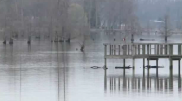A Year After The Spill: What 'Restoration' Means To BP
Sometime this year, British Petroleum changed the language on the section of their website dedicated to the Deepwater Horizon disaster. What was once "Gulf of Mexico response" has become "Gulf of Mexico restoration." A section within is titled "How we responded" -- past tense -- that outlines four ways they have provided relief: cleanup, rehabilitation, health and compensation.
However, for as much success as BP claims to have made, there are reports of continuing damage. Scientists, researchers, and community members alike tell a story of loss and struggle, a narrative that's altogether missing from the oil company's record.
Now a year after the disaster, here's how BP's claims hold up.
Offshore and onshore clean-up:
"BP is commited [sic] to cleaning up and restoring the Gulf's beaches and marshes."
Dr. Susan Shaw, a marine toxicologist, spoke with the Bangor Daily News regarding what she saw when she dived into Louisiana's Barataria Bay. She said that oil remains everywhere, both in the sand and in the water, and she saw many animals feeding in and around the oiled areas.
"I wanted to see, almost a year after the explosion, what was happening there," she said. "I went hoping to find recovery. But I found the presence of oil everywhere I went. It was very disturbing to find so much oil in the food chain."
Indeed, the National Oceanic and Atmospheric Association says that, as of March 2011, 66 miles of shoreline remain oiled and tar balls are still washing ashore.
Out at sea, there's more to be found. Over 1.8 million gallons of dispersants were used during disaster response. When mixed, the combination of oil and dispersant chemicals become "dead zones" of toxic froth with devastating effects.
Wildlife rescue and rehabilitation:
"BP worked with nationally recognized wildlife groups to develop specific rescue and rehabilitation programs for wildlife."
BP has worked with the US Fish and Wildlife Service, the National Oceanic and Atmospheric Administration, and the National Park Service to organize their efforts. However, scientists and researchers are unsure how effective those programs really were.
Although many say that it isn't the "ecological Armageddon" that was predicted, Christopher D’Elia, dean at the School of the Coast and Environment at Louisiana State University, told KOB Eyewitness News that the Gulf is still experiencing substantial trouble.
"There are these cascading effects," he said. "It could be accumulation of toxins in the food chain, or changes in the food web. Some species might dominate."
Along with the death of hundreds of dolphins in the region, CNN reports that the toxicity of the water may have contributed to an unusually high amount of deaths among the Gulf's population of Kemp's Ridley Sea Turtles, which are the most endangered turtle species in the world.
However, George Crozier, director of Dauphin Island Sea Lab, told CNN that assessing whether or not the oil contributed to deaths is a tricky dance.
"It will be critical to monitor these key species in the months ahead, especially given the unknown impacts of weathered and 'dispersed' oil remaining in the Gulf."
Todd Baker of the Louisiana Department of Wildlife and Fisheries told the Associated Press that area mangroves, a crucial plant that some bird species use for nesting, is returning in some areas. However, Baker says that others have not yet rebounded, not just because of oil but because of poor methods used to capture the oil.
"This area in front of you is typical for what happens when boom is not maintained and it's allowed to roll up in the marsh."
LOOK:
Health and safety in the response effort:
"BP worked to safeguard the safety and welfare of approximately 48,000 individuals involved in the response."
Beyond the 28 rig workers either killed or injured, the spill has made an impact on the quality of human life.
Wilma Subra, a chemist who works with the Louisiana Environmental Action Network, told The New York Times that people’s health issues are simply not being handled.
"Not only are we not prepared to handle the amount of crude that was spilled into the gulf and not prepared to handle the environmental impact, but clearly the human health impacts are not being addressed."
Some are claiming to experience a variety of health problems in the months after coming into contact with oil and dispersant chemicals. During cleanup, many complained of burning eyes and skin, however more than a year later, cleanup workers are complaining of more severe symptoms.
The AFP calls it a "mystery illness," where people in and around the disaster experience a wide range of crippling health problems, from nausea and ear infections to dizziness and memory loss.
Mike Robichaux, a doctor near Raceland, La., told the AFP that he's seen 60 similar cases nearly a year after the spill.
"Ninety percent of them are getting worse... Nobody has a clue as to what it is."
Al-Jazeera also reported on the epidemic. Toxicologists like Lou-Ann White maintain that it's impossible to correlate the events, however no other explanation is given.
The Centers for Disease Control and Prevention is currently monitoring health for cleanup workers, and the U.S. National Institutes of Health just launched a program to study the workers' health over a 10-year period of time, but no connection has yet been determined.
Even harder to gauge is the emotional toll the disaster wrought upon local communities.
USA Today reports that, since the disaster, domestic violence is on the rise. Last year, the amount of women and children at shelters increased 81 percent between April and June.
A study that came out of University of Colorado Boulder's Natural Hazards Center said that the disaster's social and psychological effects will last for years, just as it did for the community surrounding the Exxon Valdez oil spill.
And due to that distress, doctors say that symptoms related to a highly stressful state, such as gastrointestinal problems and muscle pain, are also on the rise. Gary Wiltz, of the Teche Action Clinic, told USA Today that a lot of the people he sees are severely worried for the future as other options for employment simply aren't there.
"A lot of them quit school, so they have no other skill set," Wiltz says of his patients. "They're very good at what they’re doing, but they can’t do it now; they can’t fish their way out of it."
Compensating the people and communities affected:
"BP was determined to respond swiftly and fairly to claims from individuals, businesses and government officials."
Financial worries remain as hundreds of thousands of claims for compensation have still gone unanswered. Out of the $20 billion dollars set aside, less than $4 billion has been paid out.
And due to the method of cash disbursements, some receiving funds are unwittingly contributing to the demise of their local economy. Propublica reports that the less money fishermen made in 2010 equaled fatter final payouts from BP, meaning that staying home would eventually earn them more in the long run. However, that strategy may decimate their industry. As working relationships fade, seafood buyers have moved on to other suppliers, with no word on whether they would return.
Meanwhile, government officials profited from the spill. An investigation by the Associated Press showed that many officials spent millions of BP's compensation dollars on technological upgrades, new cars and enforcement gadgets.
Louis Skrmetta, a business owner still waiting for compensation funds, told the AP that he didn't understand why businesses weren't given priority -- at first.
"I didn't think there was much logic in it," he said. "Now, looking back in retrospect, it was a way to win over politicians, a way to win over the media."






